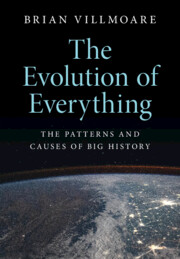Book contents
- The Evolution of Everything
- The Evolution of Everything
- Copyright page
- Contents
- Figure Credits
- Acknowledgments
- Chapter 1: Introduction
- Part I Introduction to the Scientific Perspective on the Past
- Chapter 2: The Origins of the Universe
- Chapter 3: The Structure and History of the Earth
- Chapter 4: Life
- Chapter 5: Evolution
- Chapter 6: Genetics
- Chapter 7: The Evolution of Complex Life
- Chapter 8: The Cambrian Explosion
- Chapter 9: Fish and Land Animals
- Chapter 10: Protohumans
- Chapter 11: The Genus Homo
- Chapter 12: Human Variation
- Chapter 13: Evolution and Human Behavior
- Chapter 14: Brain Evolution
- Chapter 15: Chaos and Complexity
- Part II Science and History
- Additional Readings
- Index
Chapter 9: - Fish and Land Animals
from Part I - Introduction to the Scientific Perspective on the Past
Published online by Cambridge University Press: 03 November 2022
- The Evolution of Everything
- The Evolution of Everything
- Copyright page
- Contents
- Figure Credits
- Acknowledgments
- Chapter 1: Introduction
- Part I Introduction to the Scientific Perspective on the Past
- Chapter 2: The Origins of the Universe
- Chapter 3: The Structure and History of the Earth
- Chapter 4: Life
- Chapter 5: Evolution
- Chapter 6: Genetics
- Chapter 7: The Evolution of Complex Life
- Chapter 8: The Cambrian Explosion
- Chapter 9: Fish and Land Animals
- Chapter 10: Protohumans
- Chapter 11: The Genus Homo
- Chapter 12: Human Variation
- Chapter 13: Evolution and Human Behavior
- Chapter 14: Brain Evolution
- Chapter 15: Chaos and Complexity
- Part II Science and History
- Additional Readings
- Index
Summary
The Cambrian unleashed the forces of evolution, giving rise to new anatomical adaptations that still form parts of modern animal anatomy. The evolution of the mandible, hyoid cartilage, cricoid cartilage, and styloid ligament from the gill arches of a hagfish-like ancestor is one of the most consequential adaptations. In this time period we also see the evolution of the bony cranium of vertebrates, first seen in armored predators such as the large placoderm, Dunkleosteus. During the Devonian we see the evolution of vertebrate fish diversity and, importantly for land mammals, the appearance of the lobe-finned fishes and the first land animals with a full shoulder and pelvic girdle. Although this chapter provides a broad overview of animal evolution (from fish to amphibians to dinosaurs to mammals) over several hundred million years, the major message is that large adaptive radiations are often only possible in places where there is no competition, either because there is a new open adaptive space (as with amphibians) or because another previous group has suffered a major extinction. Life on earth, once fully established, is a zero-sum game, so for there to be winners there must be losers.
Keywords
- Type
- Chapter
- Information
- The Evolution of EverythingThe Patterns and Causes of Big History, pp. 115 - 130Publisher: Cambridge University PressPrint publication year: 2022

